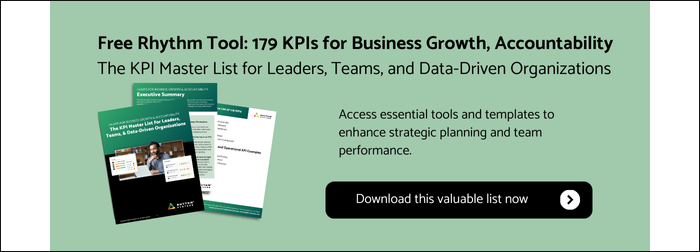Each KPI and Priority should have clearly defined success criteria. What is success? What is failure? Discuss, debate, and agree as a team.
Sounds simple, right?
For many teams, setting Red-Yellow-Green (RYG) business success criteria is a challenge. It doesn't come easily for everyone. Fortunately, it's a skill that can be learned.
First and foremost, success criteria should be SMART (specific, measurable, attainable, realistic & timely). Red, yellow, and green performance indicators are critical to hitting your goals and targets. Below are a few examples of using SMART red, yellow green performance indicators in the real world. RYG means red is substandard performance, yellow is marginal performance and green is the target performance.
1. Leave no performance metrics up to interpretation.
When setting green success criteria for KPIs or priorities, it is crucial to be precise and leave no room for ambiguity. For instance, let's take the example of the KPI "Employee Health." An effective Green indicator could be a specific survey result score or a retention percentage, providing a clear benchmark for success. On the other hand, an ineffective Green would be something vague like "Employees are happy," which lacks measurability and specificity. By defining success criteria concretely and measurably, teams can align their efforts and track progress effectively.
2. Performance metrics don't always mean a number.
For tactical priorities, sometimes Green describes an outcome that signifies the completion of a specific task or project milestone. In the case of the Priority "Develop an M&A Strategy," achieving a successful Green status would entail having a well-defined strategy that has been thoroughly reviewed and approved by the board within the set timeframe. This clear and tangible outcome provides a sense of accomplishment and is a key indicator of progress toward the overall goal. By establishing such concrete criteria for success, teams can effectively track their performance and stay on course to achieve their objectives.
3. Try to avoid using dates.
When setting priorities and KPIs, it's essential to keep in mind that priorities inherently come with a deadline, while KPIs are often measured over specific time frames such as quarterly, weekly, or monthly. Simply stating a date as the green success criteria does not provide a clear understanding of what the expected outcome should be. For example, if the priority is to "Hire a new VP of Sales" with a due date of March 31, setting a green indicator as simply "3/31" lacks specificity. Instead, a more effective green criteria would be to have the new VP hired, trained, and operating independently by the deadline of March 31. This concrete and measurable result aligns with the team on the expectations and ensures that the goal is not just completed but achieved successfully.
4. KPIs, by definition, are metrics.
KPIs, by definition, are metrics that serve as quantifiable measures of performance and progress toward achieving specific objectives. They provide a clear and objective way to track success and determine whether goals are being met. By setting SMART (specific, measurable, attainable, realistic, timely) criteria for KPIs, teams can effectively monitor their performance and make informed decisions to drive continuous improvement. Ultimately, KPIs play a crucial role in guiding strategic direction and ensuring that efforts are aligned with overarching business goals.
The RYG success criteria for KPIs are always defined by a number. Example: The KPI is “Sales Revenue.” An effective Green is “$24M.” Learn more about OKRs vs KPIs.
5. Red Yellow, and Green success criteria should describe and drive results.
When setting success criteria for priorities, it's essential to focus on outcomes rather than just completing tasks. Take, for example, the Priority of "Complete 2 marketing webinars." Instead of solely measuring success by the number of webinars produced, shift the focus to the impact on results. A more effective Green indicator would be generating 100 leads from these webinars. This shift in perspective highlights the importance of driving tangible results rather than just checking off boxes. By setting success criteria based on outcomes like lead generation, teams can ensure that their efforts directly contribute to business growth and success.
6. Frame RYG criteria within the quarter time frame.
Even if a priority is a long-term project that extends beyond the quarter, it's crucial to break it down into manageable chunks and set milestones for each 13-week period. By defining success and failure in terms of a 13-week race, you can track your progress effectively and stay on target to achieve your overall goals. Performance reporting should be based on the incremental advancements made during each set time frame, allowing you to course-correct as needed and ensure steady progress toward the ultimate objective. This approach not only helps maintain focus and momentum but also provides a clear roadmap for success within a structured timeframe.
7. Make sure Green makes sense.
When setting green success criteria for a Priority or KPI, it's essential to delve deep into the specific actions or sales targets required to reach that desired outcome. By breaking down the steps or sales milestones needed to achieve the Green status, you can ensure that your goal is not only aspirational but also grounded in reality. This detailed analysis allows you to assess whether the green goal is feasible within the defined timeframe and whether it aligns with the resources and capabilities of your team. Setting unrealistic goals not only creates a sense of defeat but also hampers execution and productivity. It's crucial to strike a balance between ambition and achievability to maintain motivation and drive successful outcomes.
8. Is the team aligned on RYG success criteria?
The team should collaboratively establish RYG criteria during your planning session. It is crucial for all team members to contribute their insights and perspectives to ensure alignment and agreement on the criteria. Avoiding surprises is key; the last thing you want is to discover discrepancies in expectations during your Week 8 Weekly Meeting, particularly between you and your VP of Sales. By utilizing RYG business examples, you can effectively illustrate and communicate the correct Red, Yellow, and Green SMART success criteria, fostering a shared understanding and commitment to achieving the desired outcomes.





